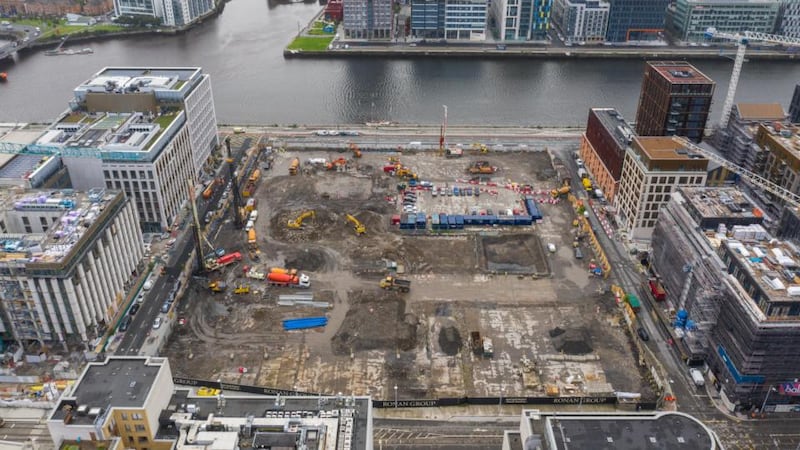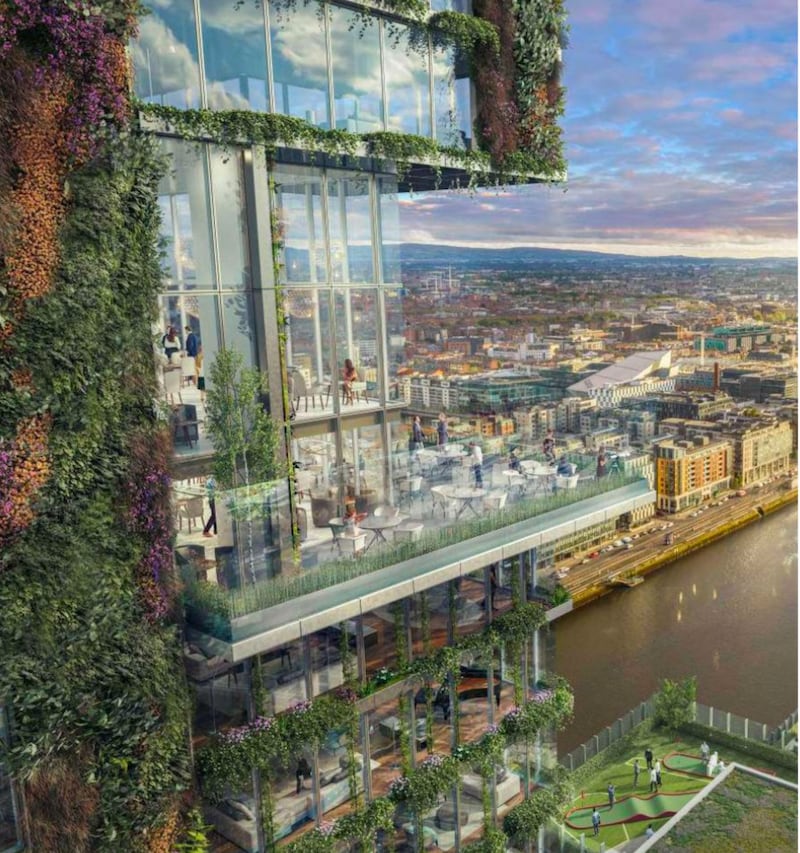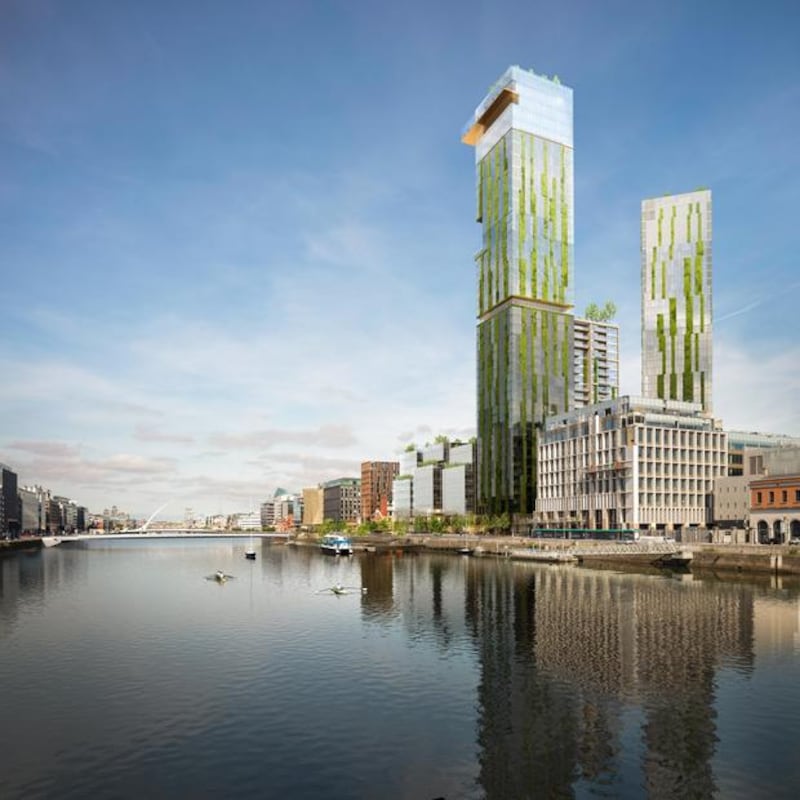Even by the bloated standards of Strategic Housing Development (SHD) applications, the volume of verbiage spewed out in support of Johnny Ronan’s Waterfront South Central mega-scheme has reached epic proportions.
It almost matches the Manhattan scale of what has been proposed for the brownfield site on Dublin’s North Wall Quay once occupied by Tilestyle’s warehouse and Tedcastle’s coalyard.
Running to thousands of pages, with copious computer-generated "visualisations", it has been compiled by a vast multidisciplinary and multinational team of consultants from the "Planning Industrial Complex" in an all-out effort to persuade An Bord Pleanála – the sole arbiter of SHD schemes – that Dublin really needs two residential towers more than 40 storeys tall.
The hyperbole swirling around the North Wall Quay scheme knows no bounds
The taller tower would rise to 167m – nearly three times the height of Liberty Hall, Dublin’s first “skyscraper” – while its smaller sister to the rear would reach a height of 146.5m, or 26.5m taller than the Spire in O’Connell Street, which is merely a stainless steel spindle. Both would stand head and shoulders above the scale of surrounding buildings in the docklands.
It would be a quantum leap in building heights in the city, far surpassing the 22-storey Capital Dock tower on Britain Quay, the city’s tallest building. Indeed, the only structures that would outstrip the proposed towers in height are the two Poolbeg stacks. Oddly-named Waterfront South Central given that it’s on the Northside, it also represents the apotheosis of “developer-led planning” in Dublin.
Estate agents Knight Frank scotch the idea that it has anything to do with failed high-rise housing schemes like Ballymun: “The tall buildings being designed and constructed today bear no resemblance to those social housing towers of the past. In many major cities, they will be concentrated in areas of major employment and are often themselves mixed use and, in many cases, mixed tenure”.
The hyperbole swirling around the North Wall Quay scheme knows no bounds. According to London-based landscape architects Cameo and Partners, “Waterfront South Central will create a proud community, which has a sense (sic) of belonging as a core value. A new part of the docks, which will reconnect to local communities and allow the city of Dublin and its residents to be proud of its future”.

Inevitably, they describe what’s proposed as “a world-class development with inspiring architectural buildings woven into an urban framework to sustain Dublin’s growth . . . a symbol of the future health and happiness of our cities; it will always stand as a marker to remember what’s important in our lives. We must learn to breathe again for the first time and reconnect ourselves for our future generations”.
We are told by Wordsearch Place, a London-based "Global Placemaking Consultancy", that these enormous erections planned by self-described buccaneer property developer Johnny Ronan – riding roughshod over the planning scheme for this part of the docklands – would be "a high-rise garden village in the heart of Dublin's new riverfront district [and] a symbol of the future of living and working in Dublin".
“Whether it’s the Eiffel Tower, the Empire State Building or The Shard, or the medieval towers of Samarkand, Lucca or San Gimignano, humans have always loved tall buildings. We’re fascinated by and drawn to them. Given the chance to go high, most people will take it; for the view, the experience, and the thrill. Tall isn’t inherently bad. Tall, in the right place and done in the right way, is amazing”.
The distance between the two towers would be only 12 metres – less than the width of Grafton Street
Wordsearch Place talk about “earning the gift of height”, saying that “to be given the right to form part of the skyline of [Dublin] is a gift that we take very seriously. We want people to look at this project and think that it is a scheme that has deserved their generosity”, unlike so “many tall buildings around the world that have been parasitic – extracting value from the city but giving nothing back”.
And so, because the two towers – one rising to 45 storeys and the other rising to 41 diagonally right behind it – would be visible across the city, they would be “owned by everyone” rather than by their owners, architects or residents. And that’s why they sought to “create a project that the people of Dublin recognise as being theirs too . . . by opening up the best parts of the project to public access”.
Thus, the scarily cantilevered viewing platform at Level 44 of the riverfront tower “will give the highest part of the building to the public”, with “stunning views of the docklands, the river, the city, the Wicklow Mountains and out to sea” as well as offering a “curated, multimedia visitor experience, charting the urban history and future of Dublin [that] will draw locals and tourists alike to the roof-top garden”.
It would also have a high-level restaurant as well as “shops and public spaces at ground-level that are well thought-out, fun and accessible”. But the most visible part of the scheme would be its “matrix of vertical and horizontal gardens and terraces . . . hanging winter gardens and atria, and the ground-level urban copse” that, together, would make Dublin’s tallest-ever tower “the greenest building in Ireland”.
The green walls would contain roosting boxes for bats and birds as well as “bug hotels” to attract bees and butterflies while space would also be provided at different levels for allotments to be tended by future residents as well as planted terraces, each one with a different “theme”. At ground level, there would even be an “edible street” lined with trees and shrubs yielding fruits, nuts and berries.

Altogether, the scheme would provide 1,005 apartments in three blocks ranging in height from eight to 45 storeys, of which 490 would be one-bedroom units, 500 two-bedroom and the remainder three-bedroom. Only 431 of the apartments would be “dual-aspect”, with views out in two directions, while the distance between the two towers would be only 12 metres – less than the width of Grafton Street.
It’s also quite windy down in the docklands, so it’s no surprise that a study found “certain areas” of balconies and terraces in the two towers would be exposed to prevailing winds, “thus scoring marginally below the standard threshold for sitting comfort”, so the design had to be modified to insert canopies to “deflect vertical drafts”, while screens were provided to “protect residents from horizontal winds”.
A total of 101 units would be social housing, to meet the developer’s obligations under Part V of the 2000 Planning Act. These would be clustered on lower levels at the rear, to facilitate “operational/ management requirements”, all with less commodious floor-to-ceiling heights of 2.7m, compared to 3.35m for standard apartments on the upper levels and 3.75m for penthouses.
The scheme materially contravenes the 2014 North Lotts masterplan, which envisaged buildings of no more than eight storeys (commercial) and 10 storeys (residential) in this area
Half of the private sector apartments would be Build-To-Rent and the rest would be for sale. But given that Dublin City Council has been told that the social housing element would cost an average of €663,366 per unit, it is more than likely that private purchasers would be paying a lot more – plus very steep annual service charges to maintain the high-rise buildings and their lush landscaping.
Yet, for all of its vertical green drapery and tree-planted terraces, there is nothing revolutionary about the scheme. Buildings with “hanging gardens” have been around for a long time, going back to the Hundertwasser Haus in Vienna (1985), while more recent examples include the verdant Bosco Verticale towers in Milan, planted with 900 trees, 5,000 shrubs and 11,000 flowering plants on all levels.
London-based consultants CityDesigner, who prepared a 316-page heritage, townscape, landscape and visual impact assessment of the North Wall Quay scheme, concluded that the two towers would achieve “an equitable balance” with the general horizontality of Dublin’s topography in long views over the city from Killiney Hill, while also intruding into views from numerous locations within the city.
But their assessment suggests that the prominence of the two towers would “not diminish the significance” of architectural conservation areas in the city centre, “being either only marginally visible from them or forming part of their wider setting without being dominant over it”. Equally, the Level 44 viewing platform would provide “elevated views” of the Custom House and other “heritage assets”.
In their design statement, busy Dublin architects Henry J Lyons say the two towers needed exterior finishes of "gradiated glazing" that would "marry with the skyline and appear non-invasive" while the "matrix of horizontal and vertical green surfaces" were intended to "soften the surroundings" of the docklands area, which they characterise as "quite a hard landscape with little or no soft scapes".

There is no mention in the environmental impact assessment report of the danger of birds crashing into the high-rise glazing even though this is a well-known risk, with an estimated death toll of 200,000 per year in New York City alone. It only deals with mitigation measures to safeguard bird nests on the site when vegetation is being cleared for construction, to be “verified by a suitably qualified ecologist”.
The overall design, if not the height, has gone through several iterations before and after “pre-planning consultations” with An Bord Pleanála, in which Dublin City Council was also involved. Perhaps this explains why the form and profile of the two towers fail to convey a truly memorable image, in the way that Norman Foster’s Gherkin or Renzo Piano’s Shard in London both do, and rather emphatically.
At ground level, extraordinarily, there would be nothing to enliven the 45-storey tower on North Wall Quay, with the relatively few facilities – a restaurant, three cafes and a food market – opening onto public spaces within the scheme, including a pocket park that may not get sufficient sunlight and would therefore be uninviting due to the “overbearing impacts” of the towers, according to council planners.
More fundamentally, the scheme materially contravenes the 2014 North Lotts Strategic Development Zone (SDZ) masterplan, which envisaged buildings of no more than eight storeys (commercial) and 10 storeys (residential) in this city block – as even the developer’s own planning consultant, Tom Phillips, concedes while insisting that it’s permissible under the 2018 ministerial guidelines on Building Heights.
But Dublin City Council has pointed out that the SDZ masterplan has already been revised to take account of these guidelines, by providing for a 12-storey residential block to serve as a “local landmark” to the rear of the site on Mayor Street and a 22 to 25-storey “Liffey Gateway” residential tower on its river frontage. Coincidentally, this amended masterplan is still awaiting approval from An Bord Pleanála.
In that context, the current SHD application may be a pre-emptive strike to get permission for a scheme that’s very significantly in excess of what the new masterplan would allow. However, even if it was approved by the board, any such decision would almost certainly be challenged in the High Court, which has consistently upheld democratically-adopted SDZ masterplans, as Johnny Ronan knows well.
Ronan disagrees with my assessment that what he’s planning gives “two fingers” to Dublin’s human scale. He also spurns any suggestion that it’s of Manhattan scale. “What we’re trying to achieve at Waterfront is exactly what Paris has successfully delivered at La Défense: a modern evolution of a characterful city in the appropriate location – brownfield urban regeneration at scale, at a remove from the city core.”
Ronan says Dublin is competing on an international stage, and insists his scheme is “neither tall nor excessive” by European standards, pointing to the number of comparable schemes being built in Manchester, for example. However, the English city’s skyline is now pockmarked by random high-rise eruptions, whereas the cluster in La Défense was a planned project designed to avoid a similar fate in Paris.
Ronan believes the planning system here is broken. “Don’t you think it’s ironic is that the best place in Ireland, objectively, to accommodate meaningful height and density is the Dublin docklands, and yet DCC, in their infinite wisdom, are doing everything they can to prevent it – spending taxpayers’ money in taking on An Bord Pleanála to frustrate my schemes, rather than engaging in dialogue?”
Ronan says the current SDZ masterplan was “written at the height of the recession in 2013” following the property crash, while the revised version – commissioned by the council ostensibly to implement what he describes as “Eoghan Murphy’s height guidelines” – has been with An Bord Pleanála for almost two years. “If it had been fine, the board would surely have approved it by now.”
As he sees it, “the history of the great Dublin estates from Gardiner to Fitzwilliam shows that developers made bold proposals that have stood the test of time”. He also revels in all the “positive feedback” from younger people on social media that’s “at odds with the conservatism of the usual armchair experts. The former and not the latter are our market.”
If only they could afford it.
The deadline for submissions to An Bord Pleanála for or against the proposal is Thursday, March 4th. It costs €20.
[ waterfrontsouthcentralshd.ieOpens in new window ]
.
















